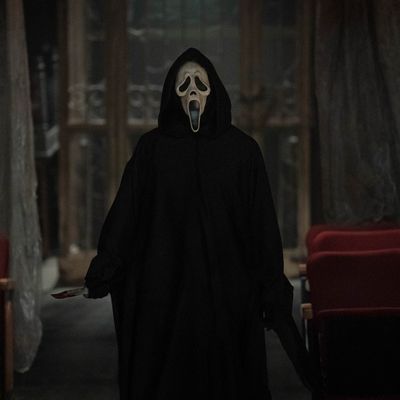
Those of us who found the very idea of Scream sequels distasteful lost that battle a long time ago. Wes Craven’s original 1996 film, based on a memorably self-aware script by Kevin Williamson in which characters kept noting that they were in a horror movie even as they were being slaughtered, hit Generation X in our sweet spot: It both scoffed and indulged, sending up the slasher movie while also delivering an enormously entertaining example of one. Scream’s po-mo self-awareness actually made its characters more relatable and the scares more visceral. This was an idea that the director had been experimenting with in a number of works leading up to that one (most notably, in 1994’s Wes Craven’s New Nightmare, a Freddy Krueger movie in which much of the cast and crew, including Craven himself, played variations on themselves).
Those who were alive and conscious in the late 1990s might recall that the first Scream made slasher movies cool again. This came after a long period in which the subgenre had fallen into disrepair, thanks partly to the endless churn of uninspired, monotonous sequels to seemingly any random piece of celluloid in which some random masked maniac killed some random teenagers. And so, Scream became a victim of its own success, generating its own spate of repetitive follow-ups. Despite Craven’s involvement and their popularity, the subsequent entries always felt to me like they diminished the original project. Yes, they continued their self-referentiality, even going so far as to introduce a fictional horror series called Stab that turned Scream’s own masked killer, Ghostface, into an in-movie pop-cultural icon. But now the self-referentiality just served to justify the production of more sequels.
And so, Scream has become its own little subgenre. Just as every “scary movie” has rules (or so Scream tells us), now every Scream picture has rules too, such as the scene where one of the characters breaks down just what kind of film they’re in and tries to predict what might happen next. In the last Scream (called, for some reason, Scream), Mindy Meeks-Martin (Jasmin Savoy Brown), the movie-savvy chatterbox who knows all the tropes, noted that they were in a “legacyquel” — a sequel that also served as a reboot. This time around, she announces that they’re in “a franchise.” That’s right — it took six movies and 26 years for the characters onscreen to recognize that they’re in a franchise. See what I’m getting at? The joke is so tired at this point it’s stopped making any sense.
Okay, okay, fine, but how is the actual movie? All things considered, Scream 6 could have been a lot worse. In some ways, the frayed half-heartedness of the concept has become something of an advantage. Mindy’s requisite genre breakdown now just feels like an obligatory beat; nobody seems particularly invested in it, least of all the filmmakers. Even the inevitable bad acting works, if only to raise our suspicions about certain characters. When someone awkwardly intones, “I got here as fast as I could,” is that an unintentionally poor line reading, or is it the directors trying to raise our doubts about whether this individual did, in fact, get there as fast as they could?
Scream 6 does distinguish itself in the horror set pieces. Directors Matt Bettinelli-Olpin and Tyler Gillett (who also made the previous entry) clearly grasp that these movies are, at their best, mean. Moving the setting to New York City, where sisters Tara and Sam Carpenter (Jenna Ortega and Melissa Barrera, returning from the previous film) have now settled, turns out to be a somewhat inspired choice. The filmmakers use New York (or rather, the movie’s version of New York, which happens to be Montreal and doesn’t actually look anything like New York) fairly well. There’s an admirably tense sequence set on the subway. It’s Halloween, so of course the trains are packed with people in costumes, many of them dressed as Ghostface, which might be believable to anyone who has never set foot in New York City. There’s a particularly nasty, not to mention ludicrous, bit of business conducted between two apartments across an alleyway from each other. Courteney Cox, returning as ambitious TV journalist Gale Weathers, gets chased around her fancy apartment in a suspenseful sequence filled with elaborate pratfalls. (If nothing else, these movies have maintained the slapstick qualities of Craven’s original.) The opening murder, in which Samara Weaving plays an associate film professor waiting for a blind date (yes, yes, I know), offers a crafty twist on the introduce-a-familiar-face-and-kill-them-right-away motif that runs throughout the series.
So, despite my antipathy toward the Scream-quels, I found myself gripped by enough of Scream 6 that I imagine fans of the series will embrace it. Have I just lowered my standards? (I mean, I did just refer to them as Scream-quels.) In a world where just about any movie that turns a profit, and even some that do not, now requires a follow-up, it does seem churlish to complain about one particular horror franchise that has been producing mostly successful entries for more than two decades. And if one of the great purposes of art is to describe and help us make emotional sense of the real world, maybe that’s enough. Maybe the final joke of the Scream movies is not that the characters are living in a repetitive, cliché-ridden, and cruel world — it’s that we are. The Scream series has won.
More Movie Reviews
- The Accountant 2 Can Not Be Taken Seriously
- Another Simple Favor Is So Fun, Until It Gets So Dumb
- Errol Morris Has Been Sucked Into the Gaping Maw of True Crime


